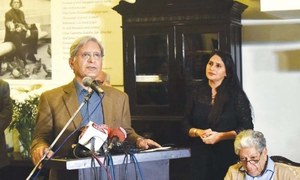 Art lovers thronged the relocated Jamil Naqsh Museum in DHA
Phase VII on Saturday evening. The museum contains a rich collection of
Naqsh’s artworks.
Art lovers thronged the relocated Jamil Naqsh Museum in DHA
Phase VII on Saturday evening. The museum contains a rich collection of
Naqsh’s artworks.
Senator Aitzaz Ahsan was the chief
guest on the occasion of the museum’s inauguration. He said he was
neither an art critic nor an expert on appreciation of art. He was there
to celebrate the work of an amazing Pakistani who gave out an image of
Pakistan that’s based on plurality of thought.
Mr Ahsan
said two images stood out in Jamil Naqsh’s paintings: one is of the
pigeon, and the other is of the woman. It reflected a deeper, more
sublime aspect of our society. There was also a third image which he
found very engaging: the eyes of the protagonists.
He
said the pigeon was a bird of peace, of togetherness. Be it Piccadilly
Square or Badshahi Masjid, pigeons bonded together, causing no harm, no
violence to anyone. The second image of the woman was more deep-rooted.
Thousands of years ago we were a matriarchal society, dominated by
women. Women spread the message of peace, and it was in our culture, our
poetry, where the urge to turn to the mother was found. In that context
the senator quoted verses from Shah Husain and Asghar Randhawa in which
the mother was invoked.
Mr Ahsan said the third image,
of the eyes, engaged you and spoke with you. That speech [of the eyes]
was nonviolent. The eyes that Naqsh painted not only looked at the world
from the inside to the outside, but if you pondered on them you would
notice that they were in fact looking from the outside to the inside.
Mr
Ahsan said the important thing besides the three images was what
distinguished human beings from animals, and the civilised man from the
uncivilised man. They were three things: intellect, altruism and the
aesthetic sense. Altruism also meant compassion, which was a faculty
that we needed to develop in our world today. The aesthetic sense was to
do with appreciating beauty … in art, in poetry, in nature, in
situations that appeared to be dire. This is what we needed to adopt
today as our values. We must use our intellect, altruistic motives and
appreciate the beauty in others, because nobody is perfect. So the thing
that art taught us was that there must be plurality and diversity.
After
Mr Ahsan’s speech Dr Faridoon Sethna informed the guests about the new
museum. He said though it was set up in 1999 and functioning for 18
years, it had not benefitted from a permanent and easily accessible
location. The new location would add to the landscape of the city.